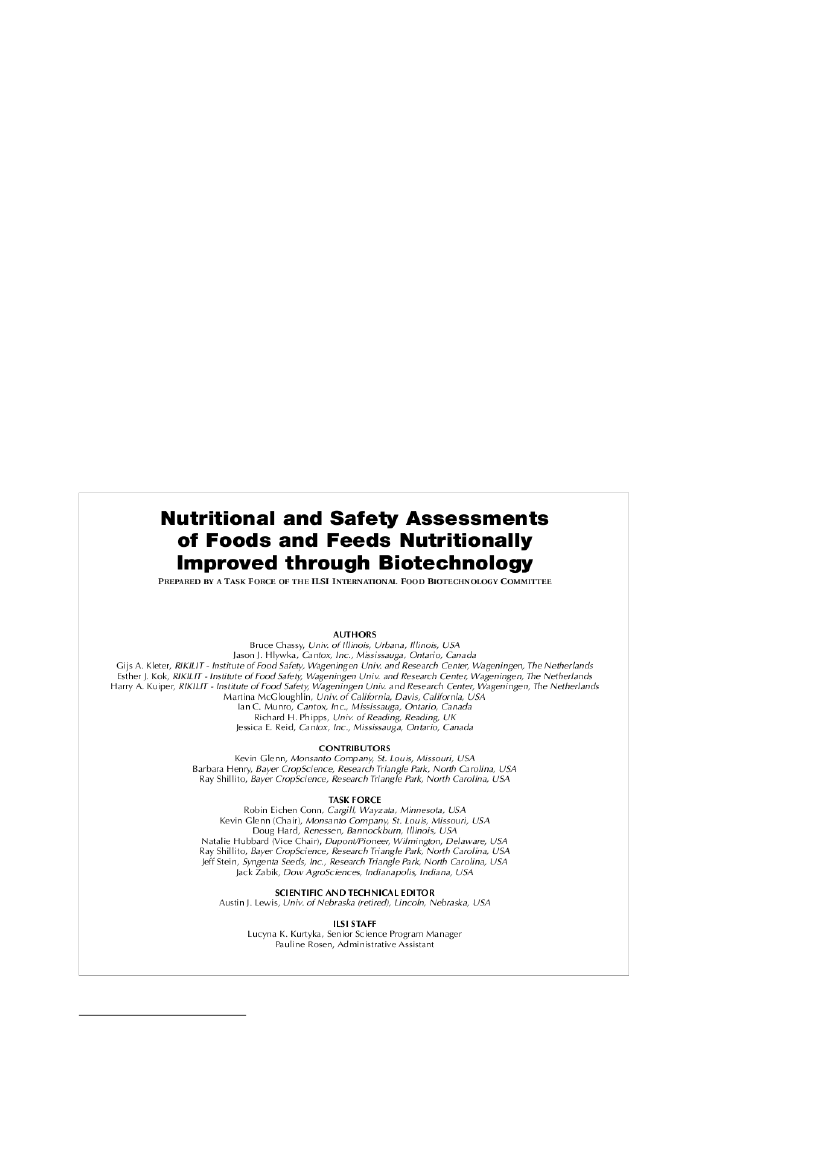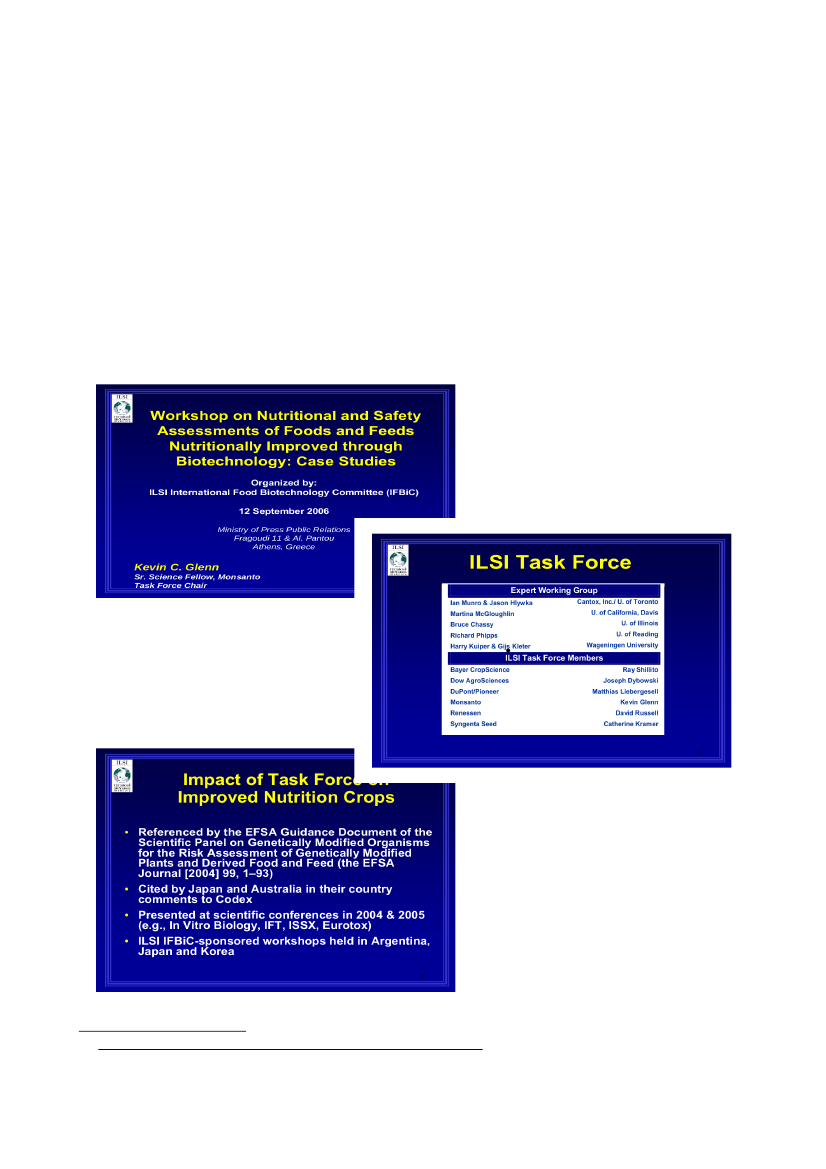Udvalget for Fødevarer, Landbrug og Fiskeri 2010-11 (1. samling)
FLF Alm.del Bilag 133
Offentligt
TESTBIOTECH Background 1-12-2010
European Food Safety Authority:A playing field for the biotech industryStandards for risk assessment massively influenced byindustry
Christoph Then and Andreas Bauer-Panskus
Table of ContentsSummary...............................................................................................................................................21. Introduction .....................................................................................................................................32. How the ILSI impacts the EFSA risk assessment of genetically engineered plants ......................32.1 The ILSI Task Force ..............................................................................................................42.2 ILSI, EFSA and the Concept of Comparative Assessment.....................................................52.3. Further cooperation between ILSI and EFSA .......................................................................83. Conclusions ...................................................................................................................................10Sources ...............................................................................................................................................11
1
Testbiotech Background EFSA & ILSI
SummaryTestbiotech investigations have revealed that conflicts of interest have a severe impact on the workof the GMOPanelat the Food Safety Authority (EFSA). The EFSA GMOPanelis responsible forthe risk assessment of genetically engineered plants. Harry Kuiper, a leading scientist there since2003, chairs the EFSA GMOPanel.Just before he joined the EFSA, he worked for a so-calledTaskForceestablished by theInternational Life Sciences Institute(ILSI). A Monsanto member of staffheads thisTask Forceand all other members are representatives from large biotech-corporations.Even after starting work at EFSA, Kuiper is still currently active within ILSI. There is also at leastone other EFSAGMO Panelmember who has worked for theTask Force.The collaboration between ISLI and theGMO Panelexperts has had a marked effect on EFSA.According to ILSI, the work of theTask Forcehas had an impact on the EFSA guidelines for therisk assessment of genetically engineered plants.Comparative Assessmentwas implemented as astarting point for risk assessment. So-calledComparative Assessmentis based on the assumptionthat conventional breeding and genetic engineering can generally be seen as being equivalent. As aresult, the risks of genetically engineered plants are less rigorously investigated than they would beif EFSA assumed that genetic engineering and conventional breeding are basically different –whichis much more plausible from a scientific point of view.Further problems arise from the fact that ILSI set up the databank used to compare the compoundsof genetically manipulated plants with those of plants derived from conventional breeding. Thisconstellation does not appear to provide adequate protection from targeted manipulation byindustry.Further evidence that the ILSI influences the EFSAGMO Panelhas been found in the context offeeding trials. EFSA does not normally require feeding studies using genetically engineered to testfor potential health impacts. The document published by EFSA to explain why feeding trials are notnecessary, was partially plagiarized from an ILSI paper.The Testbiotech investigation cannot give a fully comprehensive picture of the situation. Morelikely this is only the tip of the iceberg. The risk assessment of genetically engineered plants hasbeen influenced by the relationship between the EFSAGMO Panelexperts and biotech industry onseveral levels, and this is cause for concern.Testbiotech recommends a far-reaching re-organisation of EFSA with significant participation ofenvironmental and consumer organisations. As a first step, all members of staff, experts andmembers of the EFSA management board active in ILSI should step down from their positions atEFSA.
2
Testbiotech Background EFSA & ILSI
1. IntroductionThe European Food Safety Agency (EFSA) was established in 2002. One of its tasks is the riskassessment of genetically engineered plants. This kind of risk assessment is based on EUregulations that foresee a high standard of safety for consumers and the environment, based on theprecautionary principle (Directive 2001/18, Regulation 1829/2003). The EFSA is responsible forthe practical application of these regulations in the context of market applications. A department forthe risk assessment of genetically engineered plants (GMOUnit) was set up in 2003 to coordinatean expert panel, the so calledGMO Panel.TheGMO Unitwas headed by Suzy Renckens. HarryKuiper (originally from RIKILT Institute at the University of Wageningen) chaired the scientificwork of theGMO Panel.TheGMO Panelpublished risk assessment guidelines in 2004. Since then several furtherdocuments have been published, dealing with various issues of risk assessment such asenvironmental risk assessment, animal feeding trials, allergenicity risk and monitoring. There hasbeen a lot of criticism from various stakeholders that the work of EFSA is inadequate to fulfil EUrequirements (see for example EU Commission, 20061). Reports (so-called opinions) prepared bythe EFSAGMO Panelhave failed to gained necessary majorities in the EU Council voting.The following overview shows that EFSA guidelines are influenced by industry. The most relevantdrivers in this context are theInternational Life Sciences Institute(ILSI) and the chair of the EFSAGMO Panel,Harry Kuiper.
2. How the ILSI impacts the EFSA risk assessment ofgenetically engineered plantsILSI has its headquarters in the US and maintains that it is not influenced by any vested interestsfrom industry (ILSI 2004):“The International Life Sciences Institute (ILSI) is a non-profit worldwide foundation established in1978 to advance the understanding of scientific issues relating to nutrition, food safety, toxicology,risk assessment, and the environment. ILSI also works to provide the science base for globalharmonization in these areas. By bringing together scientists from academia, government, industry,and the public sector, ILSI seeks a balanced approach to solving problems of common concern forthe well-being of the general public.”
The work of the ILSI has been greatly criticized for many years mainly because of its closecooperation with the tobacco industry to which WHO publicly objected.2More recently, ISLI madeheadline news because Diana Banati, a member of the EFSA management board, was also activewithin ILSI. Banati quit ILSI after media reports.3According to further research by the Germanmedia, ILSI also had an impact on the risk assessment of potentially hazardous chemicalcompounds such as Bisphenol A.4
1 http://europa.eu/rapid/pressReleasesAction.do?reference=IP/06/498&format=HTML&aged=1&language=EN&guiLanguage=en2 http://www.who.int/tobacco/media/en/ILSI.pdf3 http://www.taz.de/1/politik/europa/artikel/1/aufseherin-gibt-industrie-job-auf/4 http://www.spiegel.de/wissenschaft/mensch/0,1518,729902,00.html
3
Testbiotech Background EFSA & ILSI
2.1 The ILSI Task ForceEspecially in the context of agri-biotechnology, there is no doubt that ILSI has a very closeconnection to industry. ILSI established aTask Forceto deal with biotechnology, all of whosemembers belong to industry. The October 2010 ILSI homepage shows (see also Fig. 4 below), thatthe following companies are currently members of theTask Force:BASF, Bayer CropSciences,Dow AgroSciences, Monsanto, Pioneer HiBred/Dupont und Syngenta.5ILSI has dealt with agri-biotechnology since at least1996, around the time that Monsanto firststarted to grow genetically engineered soy commercially. At that time agri-biotechnology faced thedifficulty of opening up the European market for its new controversial products. In 1997, ILSIestablished a European work group to deal with Novel Food.6In Europe, the RIKILT team –Institute for Food Safety at the University of Wageningen and their experts Harry Kuiper, GijsKleter and Ester Kok were amongst those who cooperated with ILSI. Harry Kuiper had alreadyworked with ILSI in 1998 (see ILSI, 1999).From around the year 2001, Harry Kuiper, Gijs Kleter and Ester Kok were working together asauthors for the ILSITask Force(ILSI, 2004, picture 1). At that time, the members of theTask Forcewere from the following companies: Cargill, Monsanto, Renessen, Dupont/Pioneer, BayerCropSciences, Syngenta, Dow AgroSciences. Kevin Glenn from Monsanto was head of theTaskForce(ILSI, 2004, ILSI 2008).
Fig. 1: ILSI, 2004, the Task Force and their authors5 http://www.ilsi.org/FoodBioTech/Pages/NutritionalandSafetyAssessments.aspx6 http://www.monsanto.com/newsviews/Documents/food_feed_safety.pdf
4
Testbiotech Background EFSA & ILSI
In parallel to his work at ILSI, Harry Kuiper was the chair of the EU project ENTRANSFOOD thatwas supported by the Commission and industry and was also dealing with the risk assessment ofgenetically engineered plants. Thus, in this context, Harry Kuiper was one of the most influentialexperts in Europe at a time when he was under contract to ILSI.During the period that Kuiper, Kleter and Kok were working as experts for the ILSITask Force,they published several papers on the risk assessment of genetically engineered plants in which thereare references to ILSI concepts (Kuiper et al., 2001; Kok & Kuiper, 2003; Kuiper & Gijs, 2003). Inthis context one of the most important issues is the so-calledComparative Assessment,which is theactual basis and starting point for the risk assessment of genetically engineered plants of EFSA´sGMO Panel.
2.2 ILSI, EFSA and the Concept of Comparative AssessmentThe concept ofComparative Assessmentis based on a comparison between genetically engineeredplants and conventionally bred plants. They are seen as being equivalent if no significantdifferences are identified in the comparison of the most important plant components:“The underlying assumption of this comparative assessment approach for GM plants is thattraditionally cultivated crops have gained a history of safe use for the normal consumer or animaland the environment. These crops can serve as a baseline for the environmental and food/feed safetyassessment of GMOs.” (EFSA 2004, page 12)
In short, the concept ofComparative Assessmenthelps to simplify risk assessment. In consequence,it avoids a more comprehensive risk assessment of genetically engineered plants. An in depthinvestigation would be necessary if genetically engineered plants were considered as substantiallydifferent from conventional plants because of the methods used in their production. In this case,which is much more plausible from a scientific point of view , a much broader concept for riskassessment would be needed (for overview see Then & Pothoff, 2009). As EFSA (2004) says:“Where no appropriate comparator can be identified, a comparative safety assessment cannot bemade and a comprehensive safety and nutritional assessment of the GM crop derived food/feed perse should be carried out.”
The concept ofComparative Assessmentis based on the previous concept ofSubstantialEquivalencedeveloped by industry and the OECD in 1993 (OECD, 1993). The concept ofSubstantial Equivalencewas criticised by various experts and stakeholders as inadequate. In 2003,Kok & Kuiper (2003), both of whom were working for the ILSITask Force,said that the olderconcept ofSubstantial Equivalenceshould be renamedComparative Assessmentwith no change toits core content. The concept could then serve as a starting point for testing genetically engineeredorganisms (Kok & Kuiper, 2003):“Although the Principle of Substantial Equivalence has received comments from all types ofstakeholders (producers, regulators, consumers, evaluators, etc.), the basic idea behind the principleremains untouched. When evaluating a new or GM crop variety, comparison with available data onthe nearest comparator, as well as with similar varieties on the market, should form the initial partof the assessment procedure.”
The new concept ofComparative Assessmentwas first discussed in a joint working group of FAOand WHO (FAO/ WHO, 2000) chaired by Harry Kuiper. Between 2001 and 2003 the concept wasshaped by Harry Kuiper and his colleagues to its present day form.
5
Testbiotech Background EFSA & ILSI
In 2004, ILSI published a report on itsTask Forceand referred to the publications of Kuiper et al(2001) and the joint workshop of FAO/WHO (2000). The concept ofComparative Assessmentisdescribed as follows:“This comparative assessment process (also referred to as the concept of substantial equivalence) isa method of identifying similarities and differences between the newly developed food or feed cropand a conventional counterpart that has a history of safe use.”
Since 2003, Kuiper has headed the newly established EFSAGMO Panel,the group of expertsresponsible for the risk assessment of genetically engineered plants. Suzy Renckens, who was thehead of EFSA'sGMO Unitat this time, caused a public stir because she became a member of theagri-biotech corporation Syngenta immediately after leaving EFSA in 2008.7The team around Harry Kuiper and Suzy Renckens worked on the basic EFSAGuidance Documentfor the risk assessment of food and feed derived from genetically engineered plants (EFSA 2004).Comparative Assessmentbecame the most crucial element. Other co-authors of the guidelinedocument (EFSA 2004) were the German experts Detlev Bartsch, Hans-Joerg Buhk and JoachimSchiemann whose particular closeness to the genetic engineering industry is described elsewhere(Lorch&Then, 2008).Kuiper and his colleagues were active in several organizations (such as ILSI, EFSA, FAO/WHOand ENTRANSFOOD) and prepared several papers published in scientific magazines. This couldgive the impression that the concept ofComparative Assessmentrelies on a broad consensus of allkind of experts. On taking a closer look, however, it seems that to a large extent the concept wascreated just by the network around Harry Kuiper and his colleagues during the time he was activefor the ILSITask Force(seetable 1).YearEvents
199319992000around 20012001-2003
OECD publishes its concept of SubstantialEquivalenceHarry Kuiper writes his first report for ILSIJoint workshop of FAO & WHO chaired by Harry Kuiper discussesComparativeAssessmentHarry Kuiper, Gijs Kleter and Ester Kok become authors for the ILSITask ForceHarry Kuiper, Gijs Kleter and Ester Kok publish several papers on the risk assessmentof genetically engineered plants and the concept ofComparative Assessmentis given itscurrent shape.Harry Kuiper, Gijs Kleter and Suzy Renckens become staff members of the EFSAGMO PanelThe ILSI Task Force publishes its report particularly emphasising the concept of theComparative Assessment.EFSA publishes itsGuidance Documenton the risk assessment of food and feedderived from genetically engineered plants.Comparative Assessmentis hereby the mostimportant starting point
200320042004
Table 1: Development of the concept of Comparative Assessment, chronological overview
7 http://www.testbiotech.org/en/node/312
6
Testbiotech Background EFSA & ILSI
ILSI claims the EFSA guidelines as a success of itsTask Force:Kevin Glenn from Monsanto andchair of the ILSITask Force,pointed out at a workshop 2006 in Athens, that the ILSI (2004) reporthad had a huge impact. Both the EFSA guidelines and the negotiations on the internationalstandards contained in theCodex Alimentariuswere influenced by the ILSI report (see FAO/WHO2005, alsoFig. 3).The following explanation regarding a 2004 ILSI report is given in a 2008 ILSIreport:“In 2002, a task force of international scientific experts, convened by the ILSI Intl. FoodBiotechnology Committee (IFBiC), addressed the topic of the safety and nutritional assessments offoods and feeds that are nutritionally improved through modern biotechnology. In 2004, the taskforce’s work culminated in the publication of a report that included a series of recommendations forthe nutritional and safety assessments of such foods and feeds. This document has gained globalrecognition from organizations such as the European Food Safety Agency and has been cited byJapan and Australia in 2005 in their comments to Codex Alimentarius. The substantial equivalenceparadigm, called the comparative safety assessment process in the 2004 ILSI publication, is a basicprinciple in the document.”
Fig. 3: Presentation by Kevin Glenn, (Monsanto & ILSI) on the impacts of the ILSI Task Force88http://www.ilsi.org/FoodBioTech/Pages/ViewEventDetail.aspx?ID=1
7
Testbiotech Background EFSA & ILSI
2.3. Further cooperation between ILSI and EFSAThe publication of the ILSI report (2004) and the elaboration of EFSA´sGuidance Document(2004) is not the only example of close cooperation between Harry Kuiper and Gijs Kleter andILSI. Kuiper and Kleter are, in 2010, currently members of the EFSAGMO Panel.According toHarry Kuiper´sannual declaration of interestposted on the EFSA website, he is still, in 2010,working with ILSI.9Gijs Kleter was a member of the ILSITask Forceuntil 2007 (ILSI, 2008; alsosee Fig. 4).
Fig. 4: ILSI website, 23.10.2010, Gijs Kleter is listed as a member of the ILSI Task Force10
The impact of ILSI on EFSA is not only limited to theGuidance Documentof EFSA (2004). Forexample, striking indications for ILSI impact are evident in the EFSA position on animal feedingstudies (EFSA, 2007). EFSA does not normally require feeding studies with genetically engineeredplants to test them for potential health impacts (for overview see Then & Potthof, 2009). Thedocument published by EFSA to explain why feeding trials are not necessary, was at least partiallyplagiarized from an ILSI paper.Table 2gives an overview of passages that have more or less thesame wording in the EFSA (2007) and the ILSI (2004) reports. It is clearly the case that EFSAcopied several passages from the ILSI report.
9 http://www.ilsi.org/FoodBioTech/Pages/NutritionalandSafetyAssessments.aspx10 http://apjcn.nhri.org.tw/server/APJCN/Volume17/vol17suppl.1/229-232S13-1.pdf
8
Testbiotech Background EFSA & ILSI
ILSI, 2004
In the case of GM crops with improved nutritionalcharacteristics, livestock feeding studies with targetspecies should be conducted on a case-by-casebasis to establish the nutritional benefits that mightbe expected.In addition, livestock feeding studies with targetspecies are sometimes conducted to establish theeffect of the new feed resource on animalperformance with endpoint measurements such asfeed intake, level of animal performance, feedconversion efficiency, animal health and welfare,efficacy, and acceptability of the new feedingredient.In the case where nutritional components are to bedeposited in the consumed tissue of the animal,specific tests for content should be conducted.EFSA, 2007
Livestock feeding studies with target animalspecies should be conducted on a case-by-casebasis to establish the nutritional benefits that mightbe expected from GM plants with claimednutritional/health benefits.Livestock feeding studies with target species aresometimes conducted to establish the effect of anew feed material on animal performance withendpoint measurements such as feed intake, animalperformance, feed conversion efficiency, animalhealth and welfare, efficacy, and acceptability ofthe new feed material.In cases where GM plants have been fed tolivestock with the intention of modifying thenutritional components to be deposited in theconsumed tissue of the animal, specific tests forcontent should be conducted.The extent and type of livestock feeding studiesconducted will depend on the type of feed materialdeveloped, and their need should be determined ona case-by-case basis.The work conducted by Ridley et al. (2002)provides an excellent example of the extensivecompositional analyses conducted when comparingthe grain and forage component of HT maize(NK603) with its near isogenic counterpart and anumber of commercially grown varieties.Table 1Examples of GM plants with improvedcharacteristics intended to provide nutritional orother health benefits to consumers and/or domesticanimalsOnce compositional equivalence of the GM planthas been demonstrated, work may then be focused,where necessary, on livestock feeding studies toconfirm nutritional equivalence, and to obtainfurther information on the safety.The extent and type of livestock feeding studiesconducted will depend on the type of feed resourcedeveloped, and their need should be determined ona case-by-case basis.Sidhu and others (2000) and Ridley and others(2002) provide an excellent example of thecompositional analyses conducted when comparingthe grain and forage component of maize modifiedfor an agronomic trait with its near isogeniccounterpart and a number of commercially grownvarieties.Table 2-1:Examples of crops genetically modified withnutritionally improved traits intended to providehealth benefits to consumers and domestic animals.Once compositional equivalence, which is acornerstone in nutritional assessment, has beendemonstrated, work then focuses, if necessary, onlivestock feeding studies to confirm nutritionalequivalence (see Appendix 5-1) and on assessingthe safety of any newly expressed components(proteins or nutrients).
Several crops with genetic modifications aimed at A number of plants with genetic modificationsimproving nutritional characteristics have beenaimed at improving nutritional characteristics haveproduced and are currently in trials (see Chapter 2). been developed (Table 1) and are currently in trials.The exact experimental and statistical design willdepend on a number of factors and will includeanimal species used in the study, the trait(s) beingassessed, and the size of expected effect, whichwill in turn affect, for example, the number ofanimals per treatment group.The exact experimental and statistical design ofanimal experiments to test the safety and nutritionalvalue of GM plants with enhanced nutritionalcharacteristics will depend on a number of factorsand will include animal species, plant trait(s) andthe size of the expected effect.
Table 2: Overview on paragraphs with similar wording that can be found both in EFSA (2007)and ILSI (2004) reports
9
Testbiotech Background EFSA & ILSI
ILSI is also important for the work of EFSA on another level. ILSI set up a databank with data fromcrop plants and it is this databank that is used to decide upon the outcome ofComparativeAssessment.11The data from genetically engineered plants is compared with conventional plant datastored in the ISLA databank. The broader the range of ILSI data that is used in the comparison, theless a change in the components of genetically engineered plants will be judged as biologicallyrelevant.This procedure involving the comparison of data from industry (from genetically engineered plants)with the data from the ILSI databank does not appear to provide adequate protection frommanipulation. It cannot be ruled out that data from industry is adapted to correspond with data fromthe ILSI databank.This databank was used, for example, in the risk assessment of SmartStax, a genetically engineeredmaize with eight additional gene constructs.12TheComparative Assessmentcarried out with datafrom the ILSI databank13revealed nothing noteworthy and therefore EFSA concluded that it was notnecessary to perform further risk assessment.In 2010, EFSA published new guidelines on the environmental risk assessment of geneticallyengineered plants (EFSA, 2010). These guidelines are also based on the concept ofComparativeAssessment.
3. ConclusionsAs the Testbiotech report shows, there is some evidence that the work of the EFSAGMO Panelhas,to an alarming degree, been impacted by the vested interests of industry. Based on currentknowledge the following recommendations can be given:•••EFSA should be reorganised at management andGMO PanellevelsExperts working for ILSI should step down from their positions at EFSA.A commission including representatives from the general public should be set up toinvestigate current EFSA standards and the extent to which EFSA has been undermined byindustry. Under these circumstances, EFSA guidelines should not be adopted as EUregulations as currently planned by the EU Commission.14EFSA should establish an additional control body, integrating stakeholders from civil societysuch as environmental and consumer organisations.
•
11 ILSI 2006. International Life Sciences Institute Crop Composition Database Version 3.0. Available from:http://www.cropcomposition.org12 http://www.efsa.europa.eu/en/scdocs/scdoc/1781.htm13 ILSI 2006. International Life Sciences Institute Crop Composition Database Version 3.0. Available from:http://www.cropcomposition.org14 http://www.testbiotech.org/en/node/334
10
Testbiotech Background EFSA & ILSI
SourcesEFSA, 2004,Guidance document of the Scientific Panel on Genetically Modified Organisms forthe risk assessment of genetically modified plants and derived food and feed, the EFSA Journal(2004) 99, 1–94EFSA, 2007,Assessment of Genetically Modified Plants and Derived Food and Feed: The Role ofAnimal Feeding Trials – Report of the EFSA GMO Panel working group on animal feeding trials:Adopted by the Scientific panel on Genetically Modified Organisms on 12 September 2007. Foodand Chemical Toxicology, Volume 46, Supplement 1, March 2008,http://www.efsa.europa.eu/EFSA/efsa_locale-1178620753812_1211902590265.htmEFSA, 2010,Panel on Genetically Modified Organisms (GMO); Guidance on the environmentalrisk assessment of genetically modified plants. EFSA Journal 2010;8(11):1879. [111 pp.].doi:10.2903/j.efsa.2010.1879. Available online: www.efsa.europa.euFAO/WHO, 2000,Safety aspects of genetically modified foods of plant origin, Report of a JointFAO/WHO Expert Consultation on Foods Derived from Biotechnology, World Health Organization,Headquarters, Geneva, Switzerland, 29 May – 2 June 2000FAO/WHO, 2005,Joint FAO/WHO Food Standards Program Codex ad Hoc intergovernmentaltask force on foods derived from biotechnology, Fifth Session, Chiba, Japan, 19–23 September2005, CX/FBT 05/5/4ILSI, 1999,Detection methods for novel foods derived from genetically modified organisms, ILSIEurope Report Services, Summary of a workshop held in June 1998, Organised by the ILSI EuropeNovel Food Task Force in collaboration with the ILSI International Food BiotechnologyCommittee.ILSI, 2004,Nutritional and safety assessments of foods and feeds nutritionally improved throughbiotechnology. Prepared by a Task Force of the ILSI International Food Biotechnology Committeeas published in IFT’s Comprehensive Reviews in Food Science and Food Safety, 2004 Institute ofFood Technologists (www.ift.org), http://www.ilsi.org/FoodBioTech/Publications/02_Nutritional%20_Safety%20Assessment%20of%20GM%20Foods_2004.pdfILSI, 2008,Assessments of Foods and Feeds Nutritionally Improved through Biotechnology: CaseStudies Prepared by a Task Force of the ILSI International Food Biotechnology Committee,Comprehensive Reviews in Food Science and Food Safety, Vol. 7, 53–113,http://www.ilsi.org/FoodBioTech/Publications/10_ILSI2008_CaseStudies_CRFSFS.pdfKok, E.J., Kuiper, H.A.,2003, Comparative safety assessment for biotech crops.Trends in Biotechnology 21: 439–444.Kuiper H.A., Kleter G.A., Noteborn H.P.J.M., Kok E.J,2001, Assessment of the food safetyissues related to genetically modified foods. Plant J 27:503–28.Kuiper H.,A. & Kleter G.,A.,2003, The scientific basis for risk assessment and regulation ofgenetically modified foods, Trends in Food Science & Technology 14 (2003) 277–293
11
Testbiotech Background EFSA & ILSI
Lorch A. & Then C.,2008, Kontrolle oder Kollaboration? Bericht für die Grünen im DeutschenBundestag,http://www.ulrike-hoefken.de/cms/default/dok/232/232885.kontrolle_oder_kollaboration_agrogentech.htmlOECD,1993, Safety Considerations for Biotechnology: Scale-up of Crop Plants. OECD, 1993,http://www.oecd.org/dataoecd/26/26/1958527.pdf?channelId=34537&homeChannelId=33703&fileTitle=Safety+Considerations+for+Biotechnology+Scale-up+of+Crop+PlantsThen, C. & Potthof, C., 2009,Risk Reloaded – Risk analysis of genetically engineered plantswithin the European Union, Testbiotech report, www.testbiotech.org
12
Testbiotech Background EFSA & ILSI












